A couple of 40ish guys drive up from L.A. to go on a wine-tasting tour of vineyards north of Santa Barbara for a few days. They get lucky with a couple of local women. The lying they use to get going with these women, not to mention certain character flaws (immaturity, impulsiveness), comes back to bite them, but the truth is faced and modest growth steps are taken.
That, in a nutshell, is Alexander Payne’s Sideways (Fox Searchlight, 10.20). It may not sound like much on the surface, but there’s a whole lot going on beneath it, believe me. The sum effect is that Sideways is one of the best films of the year. I don’t care what comes out between now and 12.31 — it stays on the top-ten list.

A day after seeing Sideways on Tuesday night, I put it into the Oscar Balloon as a Best Picture contender, as well as one for Best Director (Payne), Best Screenplay (Payne and Jim Taylor), Best Actor (Paul Giamatti), and Best Supporting Actress (Virginia Madsen). I don’t think I’m over-reacting. I know I’m not.
This is Payne’s most mature and fully realized film ever, and that’s saying something when you’re talking about the guy who made Election, About Schmidt and Citizen Ruth.
But can we agree to cool it with the wine-tasting allusions in the rave reviews to come? No sloshing the movie around in your mouth and mentioning the tannic undertaste, no coming to appreciate this or that character’s vaguely nutty flavor or subtle fruitiness…none of that.
This will be hard, I realize. If there’s ever been a movie awash in the culture of wine-loving, it’s Sideways. It says people are grapes or bottles of wine (or both), and vice versa. It observes how the potency of a life, like a bottle of good wine, can peak at a certain point and then start to inexorably lose it. (Whoa…downer, man.) It plays with the idea of a certain character having the behavioral tendencies of a Pinot grape and another character being more like a Cabernet, etc.
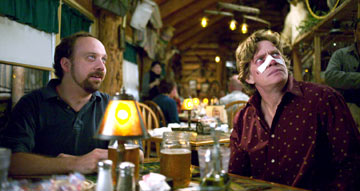
I wrote these words for the WIRED column on Thursday morning: “Sideways is fantastic in lots of small little ways that add up to one big score. It’s not a rock-your-world, drop-your-socks, home-run type of thing, but at the same time it’s damn near perfect and gets better and better the more you mull it over.”
This is what matters in spreading the word, I feel, and not the wine-lover metaphors, which will put off Joe Sixpack types for obvious reasons.
The worst thing a film can do (apart from being awful or boring you to tears) is to deliver this or that cheap high when you’re watching it but then fall apart on the way home. Sideways does the precise opposite. It’s okay at first, and then better, and then deeper and then really funny, and finally very touching. Then it seems to get even better the next morning, and better still a couple of days later.
Sideways walks and talks at times like a buddy movie, but it’s so much more emotionally mature than any buddy movie I’ve ever seen that it doesn’t feel right to call it that.
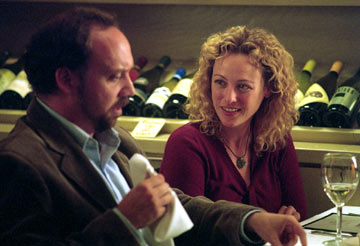
It’s mainly about Paul Giamatti’s character, a divorced wine connoisseur and would-be novelist named Miles. Calling him a guy with a downer attitude isn’t the half of it. To quote again from WIRED, Giamatti is “a master at conveying morose, cynical, self-loathing funkitude,” and he nails Miles with moves that are always sad and honest, and sometimes hilarious.
Co-stars Thomas Haden-Church and Virginia Madsen are nearly as well drawn, and the fourth character, played by Sandra Oh, is believably inhabited in every imaginable way. Haden-Church doesn’t start out as the funny half of the duo, but he sure as shit ends up that way, and without trying once to be overtly “funny.”
Although Haden-Church plays it real and earnest each step of the way, the reality is that his character, a marginally employed actor named Jack, is close to being a total goon. I’ve known plenty of guys like Jack; they see themselves as reasonably mature and aware, and they’re mostly about nine years old.
Virginia Madsen, who just turned 41, plays Giamatti’s love interest, which struck me as a bit surprising, frankly, if you follow the rule that birds of a feather go out together. She also plays the character with the most soul. She doesn’t have one of those big shouting or crying scenes that great performances are supposed to include, but every time she appears she’s grounded and heartfelt and never once seems to be “acting,” if that’s not too vaguely put.

(It’s funny but I was standing behind Madsen in the check-out line at Pavilions a few weeks ago and trying to remember what she’d last been in. If I’d seen or known about Sideways at the time, I still wouldn’t have said anything…but I wouldn’t have had all those life-is-hard thoughts. Actresses have a very tough time once they pass 35 or so.)
This is a film about some very fundamental things. It’s not an up movie, per se, but only because it’s dealing with recognizable mid-life issues — hurt, fear (of age, failure, loneliness), falling for someone special, stupidity, middle-aged adolescence — in mostly non-Hollywood ways.
And it’s got the funniest scene I’ve seen in any film since the accidental death-of-Wheezy-Joe bit in Intolerable Cruelty. And it involves terrible, turn-your-eyes-away nudity. I was laughing so hard I couldn’t stop, which got in the way of my paying attention to the follow-up scene.
So don’t take a big sip of Sideways or stick your nose in the glass. Don’t swirl it around in your mouth, and don’t wait for the flavor to grow or any of that other wine-snob crap. Just see it and write me and tell me I’m wrong about this film. It won’t happen.
World of Disappointment
[Like I said on Wednesday, I didn’t care enough about getting into a screening of Sky Captain and the World of Tomorrow, so I asked Alex Stanford, a Team Elsewhere member based in Ottawa, Canada, to weigh in.]
I collected comic books as a kid, I used to work in a video store and my current job is in the high-tech field. All of these things should have made me the perfect reviewer for this film. Who if not someone like me should be able to fully appreciate the pulp-level thrills, the homage to a classic film genre and the technical achievements that Sky Captain and the World of Tomorrow has to offer?
I didn’t.
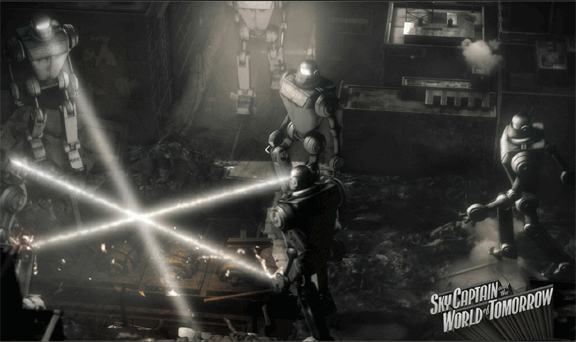
The movie starts off with intrepid reporter Polly Perkins (Gwyneth Paltrow) searching for a group of missing scientists in a stylized 1940’s New York (called Gotham City …clever!) The audience is treated to the backstory through newspaper headlines and radio-news voiceovers, and for the most part the intro works. The problems begin when it’s time to greet our hero.
Sky Captain (Jude Law) is a mercenary for hire, but for what, exactly, we’re never told. He has a fantastic array of gadgets and a super-secret airbase, but again, for no reason I could fathom. Maybe they were just waiting for giant robots to attack. Luckily for them, that’s exactly what happens.
The military calls in Sky Captain, who manages to stop a few of these invaders before they complete their mysterious task and leave a job well done. The only real thing that Cap does in this sequence is rescue his ex-girlfriend. Yeah, you guessed it — Polly.
The most interesting part of this film is the brief moments they lend to the investigation of why these scientists have gone missing and where the robots are coming from. This lasts only about 10 minutes, unfortunately. The rest of the film consists of set pieces and spectacles aimed at wowing an audience right until the end. And they do everything they can to keep your interest, but it always seemed forced.
From references to Indiana Jones, James Bond, THX1138, The Empire Strikes Back and Jurassic Park, you might get the idea that this film is a fun-filled action adventure. But it’s essentially a collection of scenes that hasn’t been strung together in any kind of way that lets you just “enjoy” it for the fun stuff.
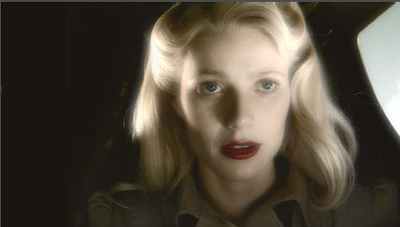
There’s a serviceable enough plot in this film, but unfortunately they don’t give you enough time to appreciate it. I’m reminded of the scene in Spaceballs where the evil plan is revealed in intricate detail, and Rick Moranis looks at the screen and says, “Everybody got that? Good.”
Before you know it, we’re brought to another locale or given another whimsical exchange between Polly and Cap. It felt after a while that we were just moments away from having the “Mystery Science Theatre 3000” silhouettes show up.
The characters all seem to be stereotypes: The Hero, The Dame, The Other Woman, The Sidekick , The Villain. I suppose that, given a green screen and little script to work from, each of the actors involved were expected to bring as much as they could to the roles.
Jude Law plays the square-jawed-Joe as well as could be expected. He’s dashing and heroic, but never more than a plot outline. Gwyneth Paltrow does a good job in trying to weave herself into every facet of her character, but unfortunately she’s more whiny than intrepid. Give me Jennifer Jason Leigh from The Hudsucker Proxy any day.
Angelina Jolie has ceased to be an actress, and now resides in the pre-Matchstick Men, Jerry Bruckheimer era of Nic Cage-styled acting. If someone told me that she was totally created in CGI, I wouldn’t blink an eye.
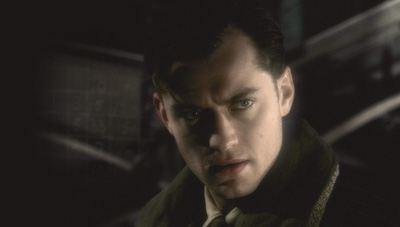
I can’t say much about the villain as it might infringe on the surprise element, but I’m still waiting for the payoff. And the bad guy’s Darth Maul-esque sidekick (played by Bai Ling, another character that could have been all CGI) was, again, less a character than a plot device.
The only character I actually liked was Dex (Giovanni Ribisi), Sky Captain’s sidekick, who played kinda like Q from the Bond films. He was surprisingly subtle, and looked like he actually gave some thought into his role. They must have filmed his scenes separately.
I loved the concept-y art of this thing. The tall buildings, shapes and textures sraddle the line between fantasy and history, and are fairly fantastic. Unfortunately, it still felt like they were in front of a green screen for any of the large set pieces. The only time it works is when they’re in close-quarters like a lab or a storeroom, and there are a few more tangible items around to give the feeling of depth.
Gwyneth runs away from robots for a few minutes at the start of this film, and she may as well have been running on stage with the film projected behind her.
Using soft lighting to cover up the line between real and animated was a good choice. The animators obviously knew their weakness here and tried to turn it into a strength by making it part of the look of the film. Unfortunately, most of the scenes come off looking like the characters are sitting around a campfire with a flashlight pointing up at their faces.

The creators also knew that that the human form is hard to animate realistically, and so they did everything but that. There are a few times (in the movie theatre scene, the air platform, etc…) where they are forced to fill a room or a walkway with people, and they look positively flat. But they nail the robots, the vehicles, the mountains and the dinosaurs.
Yup, dinosaurs. Don’t ask.
There are a few exchanges between Polly and Cap that do work, the film is fun in several sequences, but aside from that, forget it. This is purely a film in service of visual graphics, instead of the other way around.
And it’s too bad, because it is quite obvious that writer/director Kerry Conran has some real talent. I think that computer graphics have come a long way in the last decade, but still aren’t up to carrying a film. The audience is so used to seeing them employed for “the big payoff” that they look for it. I prefer the approach taken by some directors (e.g., David Fincher) to blend computer graphics with actual scenes to achieve shots he just couldn’t get with a regular camera setup.
And I don’t care how many modificiations Dex comes up with, there’s no way a plane can fly underwater. I think they were just trying to piss me off, as they do it twice . Oh, and another thing: this film definitely wins the award for “worst inclusion of ‘Somewhere over the rainbow’ since Face/Off. I’m just saying.
At best, Sky Captain is an interesting failure. The younger crowd might enjoy it, but any sophisticated moviegoer is going to have a hard time.
Familiar
In his Wednesday column filed from the Toronto Film Festival, MCN’s Len Klady writes:
“When I hit the circuit Wednesday the atmosphere had changed. The wattage level had dropped conspicuously and the press/industry participation seemed to have diminished to almost nothing. The change was so dramatic and abrupt that I began to doubt the obvious and found myself asking others whether they were experiencing it too.
“‘It’s over,’ said one Los Angeles-based sales rep. ‘I’m outta here tomorrow.’ A lot of other people came for the weekend and departed on Tuesday and as the festival nears its conclusion, there’s precious little on the horizon set to debut that was among the must-see titles.”
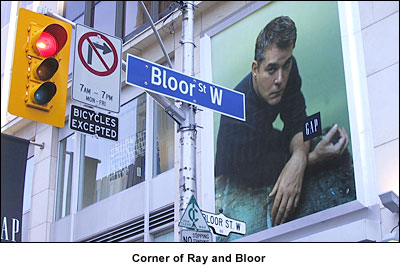
One year earlier, I wrote the following dispatch from Toronto:
“The Toronto Film Festival began to suddenly downshift on Wednesday [9.10.03], revealing a fact that is not widely known: this is a five-day festival that happens to run for ten days. Trust me, the juice was all-but-gone as of midnight on Tuesday, 9.9. Nearly all of the hot-ticket attractions were press-screened the first five days, primarily to accomodate the film-buying community which prefers to get in and get out, fast.”
Eight months earlier, I wrote the following from Park City, Utah on 1.23.03:
“The ’04 Sundance Film Festival ran out of steam about two days ago. Sometime late Wednesday afternoon, I’d say. You could feel it everywhere. Familiar faces were missing. Main Street wasn’t as crowded. Journalists and ticket-holders were still going to films yesterday (i.e., Thursday), but the spark was gone.
“There’s a reason that festival programmers always front-load this festival. People quit after five or six days. Seven days max. Even if you’re 22 years old and in perfect health, your body rebels at a certain point.”
To Arms?
“I appreciate your spreading the word about Universal Home Video’s forthcoming DVD release of Charley Varrick. But did you read the info in Uni’s link? It says that the title will be released in an aspect ratio of 1.33:1. Full frame. Modified to fit your screen.
“Didn’t you recently run a screed against Sony for doing same with their release of Castle Keep? Given your position of influence, reporting the release of a ‘modified’ DVD only feeds the fire of ignorance, and indeed, sends the wrong message to the studios, and…well,you know it, man.
“We DVD fans sometime unreasonably demand the moon, but in the case of Charley Varrick, all we want is the OAR (original aspect ratio). And a trailer. I expect you, as a passionate film fan, to insist on nothing less. How about amending your item and taking, and taking Universal to task?” — Dave S..
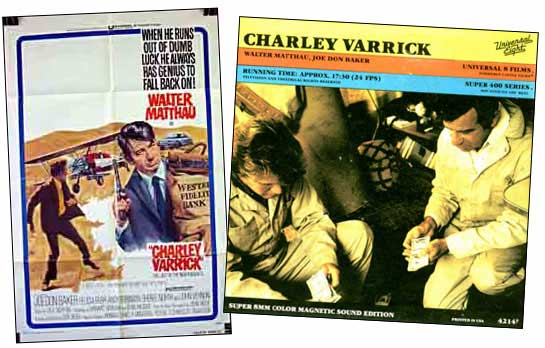
Wells to Dave S.: Original aspect ratios indeed! This doesn’t sound good. I tried asking Universal Home Video’s publicity people about this on Friday morning, but they were in a meeting.
Before you get your knickers in a twist, you should consider that there may be an upside to this situation…maybe.
First of all, Charley Varrick is not a Castle Keep because it wasn’t shot in 2.35 to 1 Scope. It was shot in the standard Academy aspect ratio of 1.33 to 1, and then either hard-matted in 1.85 on the prints, which is uncommon, or simply projected at 1.85 in theatres.
Most of the time, a 1.33 to 1 aspect tratio on a DVD means they’ve chopped off visual information, but when it came to Stanley Kubrick’s Full Metal Jacket DVD (which was a very unusual DVD mastering, granted) it meant that more information than was commonly seen in theatres was being provided. So it’s conceivable, if unlikely, that UHV’s Charley Varrick DVD will be the same kind of deal.
It wouldn’t surprise me if the forthcoming Varrick DVD will provide an image with the sides lopped off. You’re usually on safe ground if you assume laziness of the part of DVD distributors, especially when it comes to mastering older titles that aren’t regarded as Oscar-level classics, which is the case here.
Like you, I would prefer to see a Charley Varrick with as much visual information as possible. I’m just saying it doesn’t necessarily follow that a 1.85 to 1 crop will provide that. Technically, a film shot in a standard Academy ratio loses information off the top and bottom of the image it’s shown or matted at 1.85 to 1.
Aaahhh!
“I noticed in your Sideways review you talked about a funny scene that featured ‘turn-your-eyes-away nudity.’ I have yet to see the film, so i don’t know for sure, but there was a clip from Sideways that came online this spring that sounds like it could be that scene you’re talking about…only this clip wasn’t a finished scene, merely an outtake.
Well, anyway, I thought you might enjoy seeing the outtake…whether it’s that scene or not. It’s at joblo.com: http://www.joblo.com/movs/show-sideways.mov.












